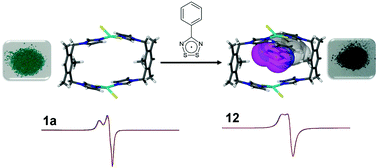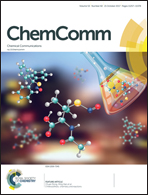Inclusion of a dithiadiazolyl radical in a seemingly non-porous solid†
Abstract
Inclusion of the dithiadiazolyl radical PhCNSSN˙ into the dynamically porous metallocycle [Cu2(L1)2Cl4], where L1 is the bidentate ligand 1,3-bis(imidazol-1-ylmethyl)-2,4,6-trimethylbenzene, has been achieved by gas phase diffusion. Single crystal X-ray diffraction, powder X-ray diffraction, UV-visible spectroscopy, EPR and SQUID magnetometry studies confirm inclusion of the radical into this seemingly non-porous material, and illustrate the antiferromagnetic coupling between the paramagnetic host and guest species. The radical guest is readily released by heating or by the addition of solvent (CH2Cl2).



 Please wait while we load your content...
Please wait while we load your content...